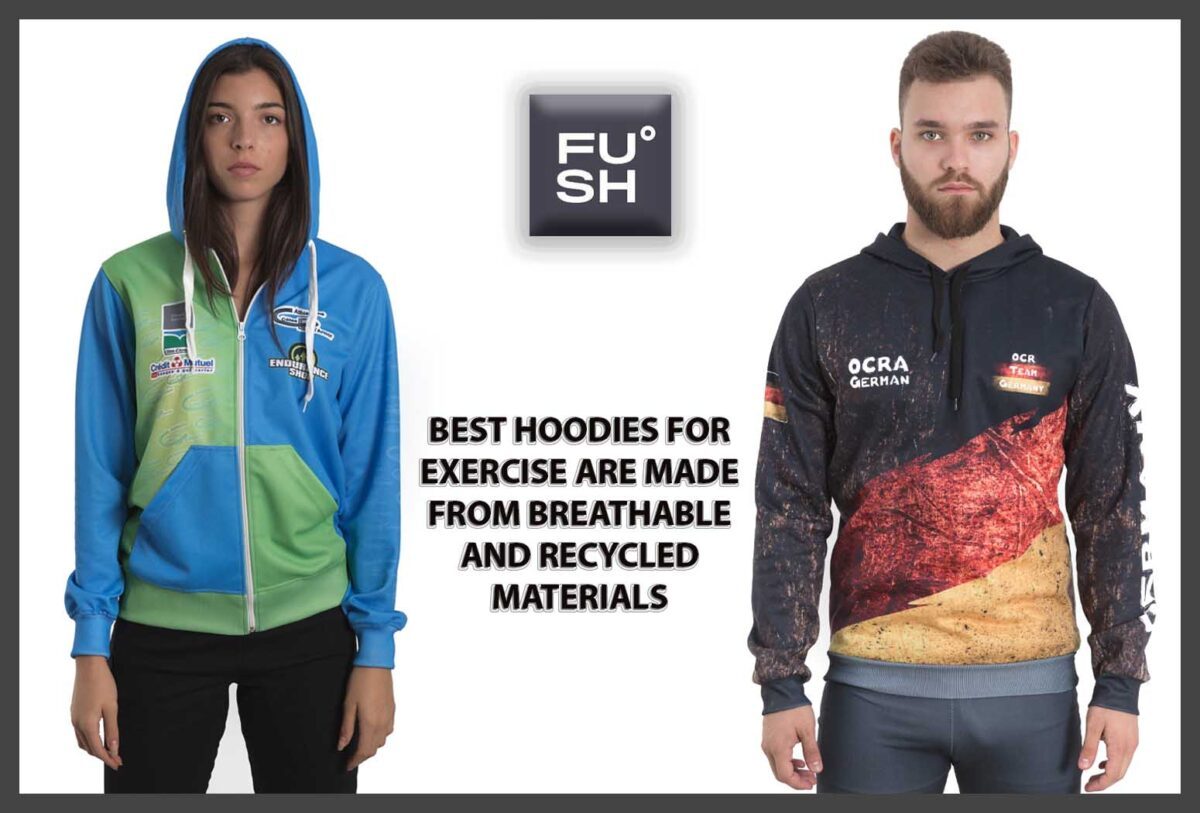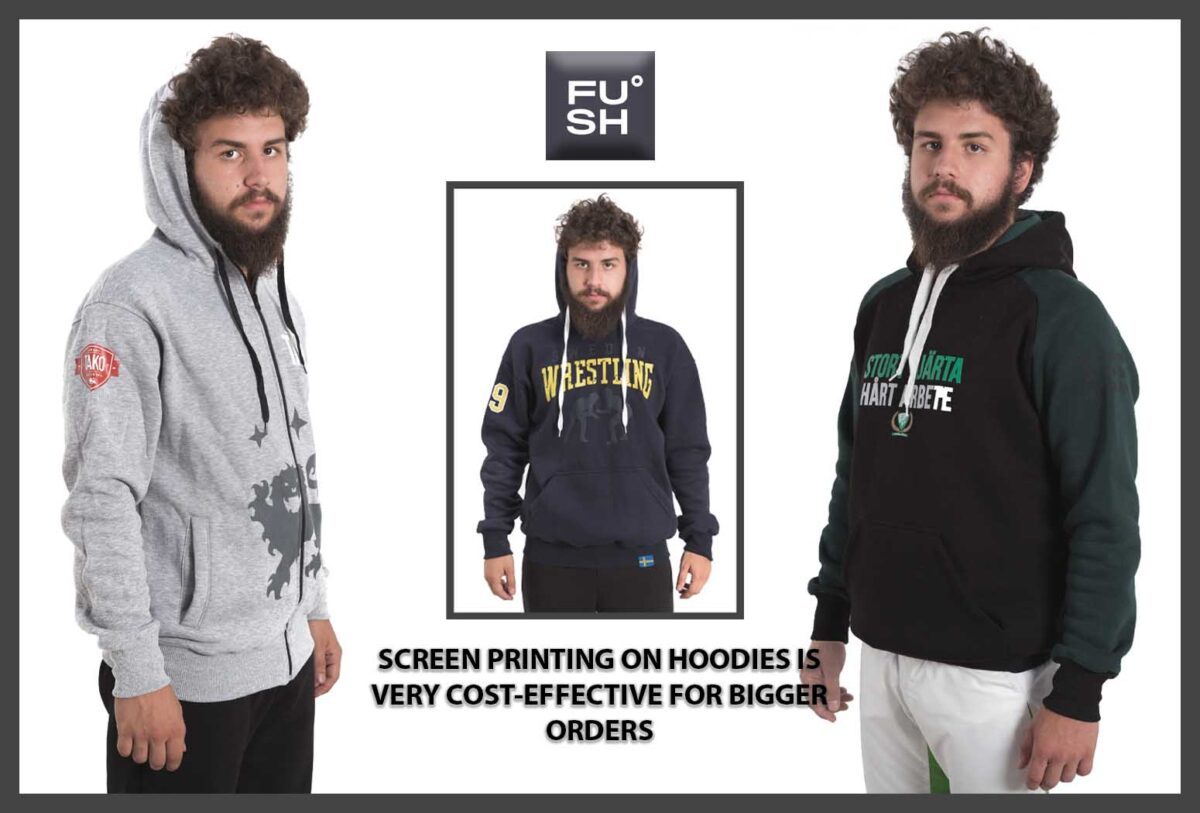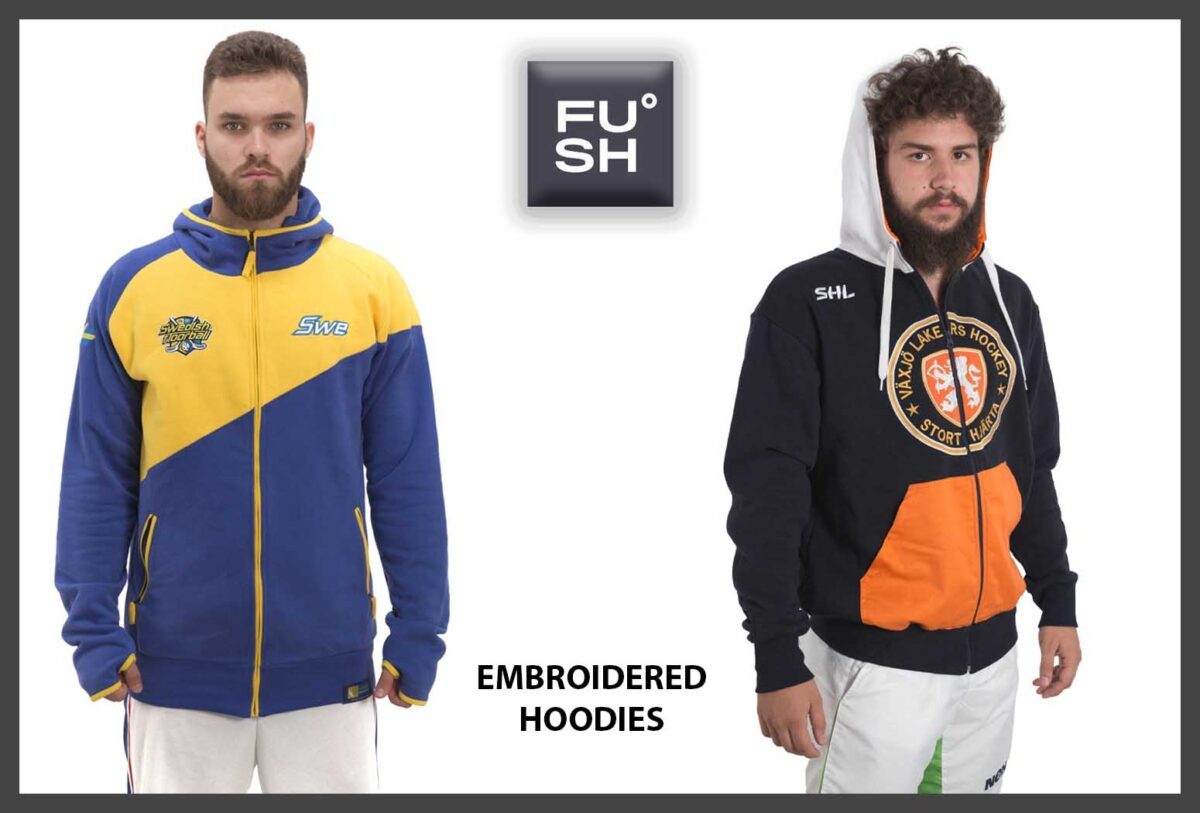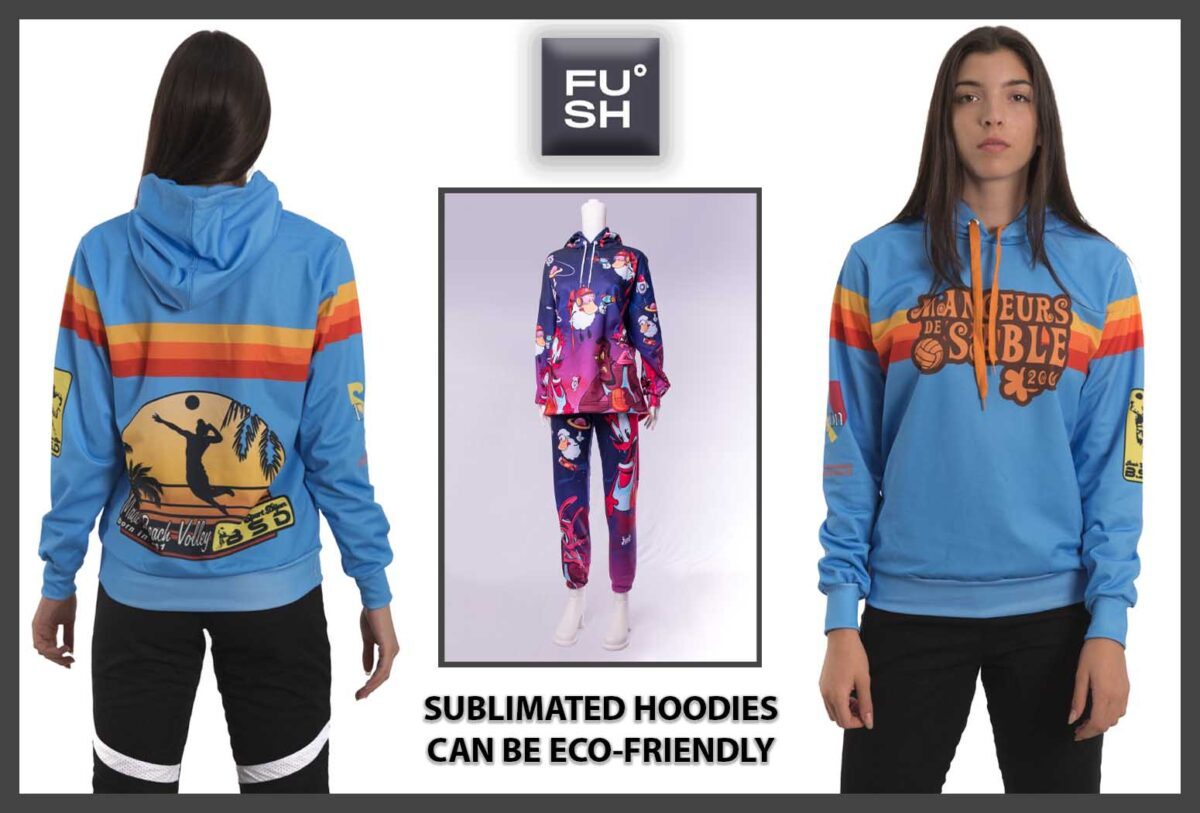A fully customized hoodie is much more than choosing a colour and a print location for your logo.
It’s a garment where you, the client, can ask any of the following from your custom hoodie manufacturers:
- Fabric type (eg. cotton, polyester, blend, bamboo)
- Its knit structure (eg. single jersey, double jersey, fleece)
- The shape of each segment (eg. front, back, sleeve, hoodie, cuffs)
- What trimmings to use
- Colours, printing options
- Labelling
- Packaging
That level of customization is available at FUSH˚. After all, we are custom hoodie manufacturers. As such, we offer a minimum order quantity (MOQ) of 500 pieces per design/colour in any size. Also, keep in mind that, to order from us, your clothing brand will have to be a business with valid VAT and EORI numbers.
Learn more about working with us – visit the what we do page.
Advice on materials from a custom hoodie manufacturer
Your choice of ideal fabrics and fabric knit structure will depend on what purpose your hoodies will serve. Exercise-oriented and lounge-oriented pieces will have different demands. Read through and find out what we think is the best choice.
Best hoodie fabrics for exercise

This type of clothing works best when a hoodie manufacturer makes it from synthetic materials. Unless GRS-certified. This is why you should seek to work with certified manufacturers.
Certified recycled polyester clothing with FUSH˚
FUSH˚ has a GRS certificate as proof that the polyester clothing that you get from us comes from genuinely recycled sources. Also, garments from our production line come with the GRS label that your customers will recognize and value more than the ones without proof of origin.
Add stretchiness to facilitate movement
Because mobility is critical for exercise clothing, a four-way stretch material with elastane is a perfect choice. We manufacture fabrics like that at our knitting mill. It’s a heavy (320 gsm*) 92% poly 8% elastane blend.
*GSM is an abbreviation for gram per square meter and it is an industry standard for weighing fabrics.
And for those allergic to synthetic materials, the dual fabric is the answer. With it, a thin layer of natural fabric is added to the contact surface, while the outer one remains synthetic.
How to further improve the sustainability of synthetic hoodies and sweatshirts?
To improve the sustainability of your polyester hoodies, you can avoid dyed and/or bleached fabrics entirely. Instead, we can dye-sublimate the material for your hoodies. That is a much more sustainable process than bleaching and dyeing. Learn more about it on the sublimation clothing page.
Openly advocate for sustainability in fashion
Use your clothing brand as a platform to educate your customers about responsible sourcing, responsible buying and wearing, as well as ways to tackle issues connected to polyester clothing, like microplastics. One of the ways to handle this problem is by using microplastic filters.
Talk about microplastic filters
Even though they’ve nothing to do with your clothing brand, advocating the use of microplastic filters shows that you are ready to fight for your planet on all fronts, even if it means plugging another business. These products significantly reduce microplastic emissions from people’s washing machines. The figure goes up to 90%!
Best fabrics for non-athletic custom hoodies
The good thing about casual wear and streetwear is that their sustainability and garment design are more important than their performance.
For that reason, we strongly advise you to go for cotton hoodies and sweatshirts.
As for the knit structure, some additional comfort would come with double knit and interlock. Interlock is especially interesting because it is more resistant to post-washing shrinkage.
Certified organic clothing with FUSH˚
FUSH˚, as a hoodie manufacturer, has a GOTS certificate and because of that can make clothing with official GOTS hang tags. They serve as proof to your customers that the cotton clothing they buy from you is genuinely organic and therefore of the highest quality.
Benefits of FUSH˚ as your custom hoodie manufacturers
We invest heavily in sustainable technologies and modern machinery. This spring/summer, we’ll become 100% energy-independent because we’ll switch to solar. Also, we use a wastewater treatment plant to ensure the water that leaves our factory is harmless to nature.
Creating custom hoodies with modern machinery
We always look to buy the best possible machines. The two we would like to highlight here are Spanish Canmartex circular knitting machines and Orox iCut, the newest automatic fabric-cutting machine from this Italian giant. Because of these machines, we can make and cut a lot of different fabrics.
Full customization of hoodies
With FUSH as your custom hoodie manufacturer, you can get:
- Customized patterns
- Extensive choice of printing and embroidering options
- Great choice of materials
- Wide variety of stitches
Pattern customization
This allows you and us full creative freedom when it comes to making patterns for your unique hoodies. Because we have a modelling department, we can even copy an existing garment from your previous collections, if you don’t have a tech pack handy.
Printing

- Dye-sublimation
- Screen printing (water-based, discharge, high density, silicone emboss)
- Heat transfer (regular and reflective transfer)
- Foil stamping (with or without glitter)
- Digital printing (currently only direct-to-fabric but we plan to expand our offer with direct-to-garment variation))
Embroidery

- Standard
- 3D (also known as raised or puffed)
- Chenille
- Sequin
- Rising thread
- Cording
Sustainable hoodies made by sustainable manufacturers

We’re both environment-focused and employee-focused when it comes to sustainability. This means that:
- We will make your hoodies from recycled or organic materials and you’ll have a way to prove it with GRS and GOTS hang tags on your high-quality hoodies
- We are a Sedex member with a successfully-passed 4-pillar SMETA audit
- People making your clothes earn at least 20% more than the national minimum wage and don’t have to work overtime to achieve that salary. Also, whenever they do work overtime, they’re paid premium rates.
- We have the ISO 14001:2015 certificate that shows our environmental management system is aligned with the strict ISO environmental principles
- Both of our factories are in Serbia so the distribution of your orders will have significantly lower CO2 emissions if you’re from Europe.
Learn more on the topic: FUSH˚ sustainability
To take an in-depth view of our factory in Oraovica, go on this virtual tour.
Also, from our recent experience, many established and growing brands that contacted us, often asked for custom t-shirts in addition to custom hoodies, so feel free to follow suit.
Manufacturing process with FUSH˚ – the ideal scenario
The fastest and least expensive way to work with us as your hoodie manufacturer is to:
- Prepare a detailed tech pack ahead of time and send it our way
- The tech pack should have precise positions for any embellishment (printed, embroidered, buttons, etc)
- It should explain what materials you need, at what weight and colour, and what stitching you prefer
- It should determine opening dimensions, binding, and top/bottom stitch for neck holes, sleeve openings, and bottom openings
- Ideally, it should show grading for each size
- We analyze the tech pack and determine our asking price and lead time
- We agree on delivery terms (if we can’t deliver your order ourselves, which courier company will do the delivery)
- If you have more styles in your tech pack, we will make a sample for each one, if you agree to it (sampling price is €100 per style)
- We make samples and send them your way for approval
- Once samples get approval from your end, we’ll charge you 50% for your order and we’ll start mass production
- According to our previous agreement, we’ll either send your order via a service like DHL or with our delivery vans (availability permitting)
- Once we send the order your way, we charge you the remaining 50%
Serbia has a free-trade agreement with the EU and UK
That means importing goods from Serbia will cost as much as importing them from the EU. The only fee you would pay is the fixed customs clearance fee, which’s always around 100€, regardless of the volume of your order. This way, you get cheaper, faster, and more reliable shipping. That’s because your deliveries will come via road instead of sea or air, from a country not too far away from your own.
And if you’re from the UK, you’ll be happy to learn that the situation has become the same as in the EU since 20 May 2021.
Final thoughts
What did we learn today?
To make a great quality hoodie for your brand, you have to find a manufacturer that:
- Has its production lines fitted for a wide range of garments and design options
- Has an experienced modelling team that can recreate garment samples you send
- Works with various fabrics of different weights
- Has previous experience with fashion brands
- Has a portfolio of different hoodie designs
- Makes hoodies with sustainable hang tag labels that will increase the trust of your customers
- Runs a nearshoring type of manufacturing (caters to markets geographically nearest to its production facilities)
Luckily for you, FUSH˚ ticks all these boxes and with all this info behind you, there’s nothing left to do but to send us an enquiry about our potential cooperation.
FAQ
How expensive is it to make a hoodie?
How much your clothing manufacturer will charge you for the production of hoodies depends on:
- The quantity you order
- Fabric composition
- The weight of the fabric
- Whether you require embroidery
- Whether you’ll need printing
Find the FUSH˚ pricing in the table below (relevant in February 2024):
| Fabric composition | 70% cotton, 30% polyester |
| Fabric weight | 320 gsm |
| Colours | CMYK |
| Embellishments | Small embroidery or screen print (maximum two colours) |
| Minimum quantity | 500 |
| Price | €20 |
| Fabric composition | 100% organic cotton |
| Fabric weight | 400 gsm |
| Colours | CMYK |
| Embellishments | Small embroidery or screen print (maximum two colours) |
| Minimum quantity | 500 |
| Price | €25 |
What is the best way to print on hoodies?
Your choice of fabric will determine the best way to print on hoodies.
Printing on natural fabrics
If you decide to use cotton, other natural fibre or even a poly-cotton blend, you’d have to use screen printing, direct-to-fabric or direct-to-garment printing (DTF). This is because these printing methods ensure the print will withstand multiple washes.
Printing on synthetic materials
If you decide to use polyester, then the best way to print on hoodies would be dye sublimation. This is because synthetic fibres absorb dye sublimation ink on a molecular level, keeping the colours fresh for a long time. Only long periods in direct sunlight may result in faster fading.
What is the best quality material for hoodies?
The best quality material for hoodies would depend on your preference.
Since hoodies come in casual wear collections, the most popular material is heavy cotton polar fleece (380 grams per square meter or more). If you want to add variety, you could go for organic linen or Tencel. These materials usually come as French terry knits, so they would also work for you if you’re not a big fan of fleece.
Request a quote from us
To get the best possible price and lead time estimate, please include the number of designs and pieces per design, fabric choice, sizes, and printing options.
- FUSH˚ Addresses:
- Velizara Stankovića 67
Belgrade, Serbia (view in Google Maps) - Oraovačka BB
Oraovica, Serbia (view in Google Maps)
- Velizara Stankovića 67
- Phone: +381 11 359 10 48
- Email: info@fush.rs